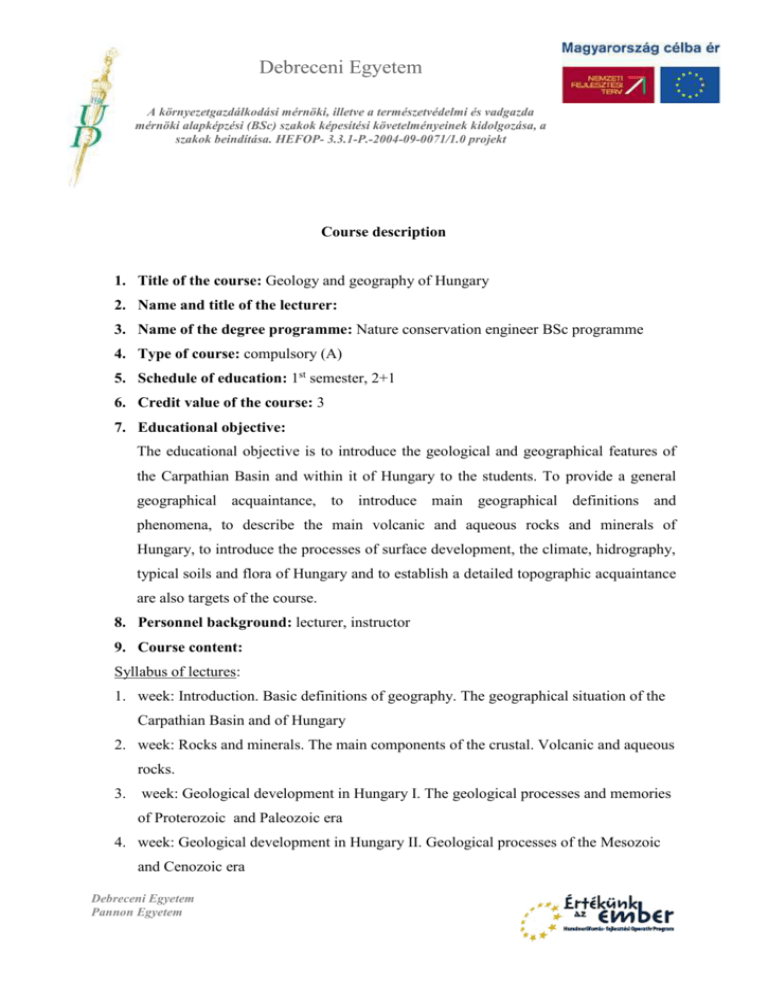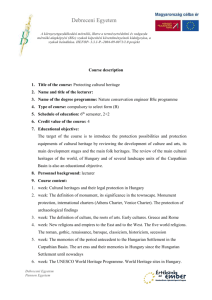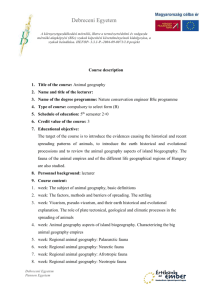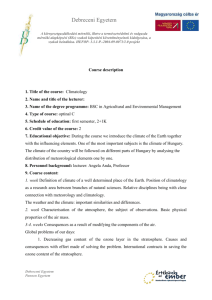Tantárgyi program - Debreceni Egyetem
advertisement

Debreceni Egyetem A környezetgazdálkodási mérnöki, illetve a természetvédelmi és vadgazda mérnöki alapképzési (BSc) szakok képesítési követelményeinek kidolgozása, a szakok beindítása. HEFOP- 3.3.1-P.-2004-09-0071/1.0 projekt Course description 1. Title of the course: Geology and geography of Hungary 2. Name and title of the lecturer: 3. Name of the degree programme: Nature conservation engineer BSc programme 4. Type of course: compulsory (A) 5. Schedule of education: 1st semester, 2+1 6. Credit value of the course: 3 7. Educational objective: The educational objective is to introduce the geological and geographical features of the Carpathian Basin and within it of Hungary to the students. To provide a general geographical acquaintance, to introduce main geographical definitions and phenomena, to describe the main volcanic and aqueous rocks and minerals of Hungary, to introduce the processes of surface development, the climate, hidrography, typical soils and flora of Hungary and to establish a detailed topographic acquaintance are also targets of the course. 8. Personnel background: lecturer, instructor 9. Course content: Syllabus of lectures: 1. week: Introduction. Basic definitions of geography. The geographical situation of the Carpathian Basin and of Hungary 2. week: Rocks and minerals. The main components of the crustal. Volcanic and aqueous rocks. 3. week: Geological development in Hungary I. The geological processes and memories of Proterozoic and Paleozoic era 4. week: Geological development in Hungary II. Geological processes of the Mesozoic and Cenozoic era Debreceni Egyetem Pannon Egyetem Debreceni Egyetem A környezetgazdálkodási mérnöki, illetve a természetvédelmi és vadgazda mérnöki alapképzési (BSc) szakok képesítési követelményeinek kidolgozása, a szakok beindítása. HEFOP- 3.3.1-P.-2004-09-0071/1.0 projekt 5. week: Mineral raw materials of Hungary. Mineral and rock associations 6. week: The climate of the Carpathian Basin and Hungary 7. week: The hidrography of the Carpathian Basin and Hungary 8. week: The soils and natural flora of Hungary 9. week: Geographical division of Hungary. General review of the geographical regions of Hungary. 10. week: Hungarian geographical regions I. The Great Plain and the Little Hungarian Plain 11. week: Hungarian geographical regions II. Western Hungary 12. week: Hungarian geographical regions III. The Transdanubian Hills and the Transdanubian Mountains 13. week: Hungarian geographical regions IV. The North Hungarian Mountains 14. week: Geographical aspects of the Hungarian national parks Syllabus of practices: 1. week: Introducing the course requirements. The Carpathian Basin on the map of Europe. Extreme geographical points 2. week: The description of volcanic and aqueous rocks 3. week: Rocks and formations linked to the Proterozoic and Paleozoic era 4. week: Formations linked to the Mesozoic and Cenozoic era 5. week: Mineral and rock identification 6. week: Climatic phenomena in Hungary 7. week: Hidrography questions of the 19th and 20th century 8. week: Flora and soil correlations. Analysing typical soil sections 9. week: I. practice test: climatic, hydrographical, pedological and plant associational definitions. Region divisions of Hungary, cultural landscape 10. week: The most characteristic features of the Great Plain and the Little Hungarian Plain, topography Debreceni Egyetem Pannon Egyetem Debreceni Egyetem A környezetgazdálkodási mérnöki, illetve a természetvédelmi és vadgazda mérnöki alapképzési (BSc) szakok képesítési követelményeinek kidolgozása, a szakok beindítása. HEFOP- 3.3.1-P.-2004-09-0071/1.0 projekt 11. week: The most characteristic features of Western Hungary and the Transdanubian Hills, topography 12. week: The most characteristic features of the Transdanubian Mountains, topography 13. week: The most characteristic features of the Northern Hungarian Mountains, topography 14. week: II. practise test from the material of the 10-13th practices 10. Mode of assessment during the semester: Continuous recording at practices, and tests after each major topic. During lectures writing two inter- semester written examinations. 11. Type of exam: terminal examination 12. Compulsory practice related to the course: none 13. Compulsory and recommended literature: Martonné, E. K. (2001): Magyarország tájföldrajza. Debreceni Egyetem. Kossuth Kiadó. Debrecen Hevesi, A. (2001): Természetföldrajzi Kislexikon. Tankönyvkiadó. Budapest 14. Exam themes: 1. Determine the geographical position of the Carpathian Basin in Europe. 2. Delineate the extreme geographical points of the Carpathian Basin. 3. List and describe briefly the geographical regions of the Carpathian Basin. 4. Determine the geographical environment of Hungary. 5. Delineate the extreme geographical points of Hungary. 6. Determine the definition of mineral and rock (give examples). 7. Group the rocks that compose the crustal (give examples). 8. List the earth historical eras and each period within them. 9. Delineate the main events of the Proterozoic and Paleozoic era from the area of Hungary. Debreceni Egyetem Pannon Egyetem Debreceni Egyetem A környezetgazdálkodási mérnöki, illetve a természetvédelmi és vadgazda mérnöki alapképzési (BSc) szakok képesítési követelményeinek kidolgozása, a szakok beindítása. HEFOP- 3.3.1-P.-2004-09-0071/1.0 projekt 10. Delineate the main events of the Mesozoic and Cenozoic era from the area of Hungary. 11. Delineate the events of the Quaternary period in Hungary. 12. List the main ores and other mineral and rock resources that could be found in Hungary. 13. Delineate the energy resources of Hungary. 14. List the elements of climate. 15. Delineate the climatic consequences of the basin character. How could you interpret the definition of “remote–controlled climate”? 16. Delineate the climatic features of Hungary. 17. Delineate the hydrographic features of Hungary. 18. Delineate the hidrography of the Danube valley. 19. Delineate the hidrography of the Tisza valley. 20. List the typical zonal woody associations of Hungary. 21. Delineate the typical zonal non-woody associations of Hungary. 22. Delineate important plant associational definitions. List relict and endemic plant species and azonic (extrazonal, intrazonal) plant associations. 23. Determine the definition of soil, and the requirements of its forming. 24. Delineate the typical soil types of Hungary. 25. Delineate the endangering factors to the Hungarian soil resources. 26. Delineate the regional division system of Hungary. List the geographical regions of Hungary. 27. Delineate the Great Plain, its forming and geographical characteristics. 28. Delineate the regions of the Great Plain, their geological and geographical characteristics. 29. Delineate the forming of the Little Hungarian Plain, its geological and geographical characteristics and regions. Debreceni Egyetem Pannon Egyetem Debreceni Egyetem A környezetgazdálkodási mérnöki, illetve a természetvédelmi és vadgazda mérnöki alapképzési (BSc) szakok képesítési követelményeinek kidolgozása, a szakok beindítása. HEFOP- 3.3.1-P.-2004-09-0071/1.0 projekt 30. Delineate the forming of the Transdanubian Hills, its geological and geographical characteristics. 31. Delineate the regions of the Transdanubian Hills and their geographical features. 32. Delineate forming of the Transdanubian Mountains, its geological and geographical characteristics. 33. Delineate the regions of the Transdanubian Mountains, their geographical regions. 34. Delineate the geological and geographical characteristics of the Balaton uplands. 35. Delineate the forming of Lower Alps and its geological and geographical characteristics. 36. Delineate the regions of Lower Alps and their geographical characteristics. 37. Delineate the forming of the Northern Hungarian Mountains and its geological characteristics. 38. Delineate the geographical characteristics of the Visegrád Mountains and the Börzsöny. 39. Delineate the geographical characteristics of the Cserhát and the Mátra. 40. Delineate the geographical characteristics of the Bükk and the Zemplén Mountains. 41. Delineate the geographical characteristics of the Aggtelek Karst and the Cserehát. 42. Delineate the geographical environment of the Aggtelek National Park. 43. Delineate the geographical environment of the Balaton National Park. 44. Delineate the geographical environment of the Bükk National Park. 45. Delineate the geographical environment of the Duna-Dráva National Park. 46. Delineate the geographical environment of the Duna-Ipoly National Park. 47. Delineate the geographical environment of the Fertő-Hanság National Park. 48. Delineate the geographical environment of the Hortobágy National Park. 49. Delineate the geographical environment of the Körös-Maros National Park. 50. Delineate the geographical environment of the Őrség National Park. Debreceni Egyetem Pannon Egyetem





